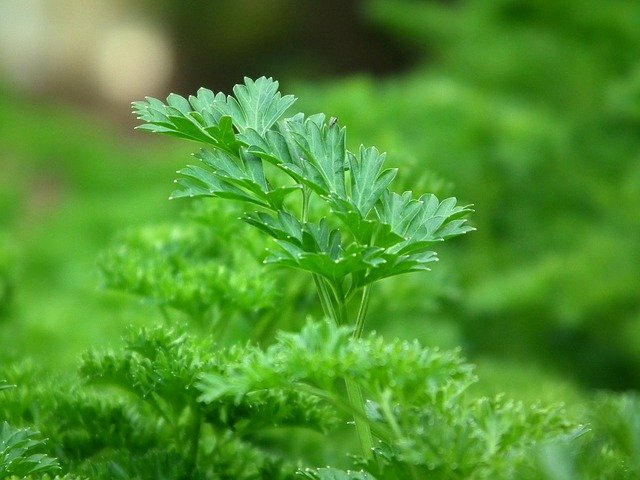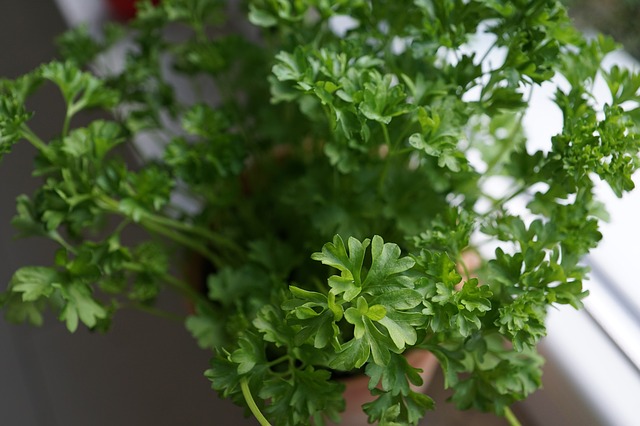
Growing & Harvesting Parsley: Tips for a Rich Harvest
Parsley is a popular culinary herb. It enhances many dishes with its essential oils, which provide a great taste. In addition to these, parsley also contains many minerals such as calcium and iron and a high proportion of vitamins A, B and C. Here you will learn what to consider when planting and sowing parsley.
This Article Contains:
- Growing Parsley: How to Sow & Plant
- The Right Location for Parsley
- Companion Planting With Parsley
- Parsley in Mixed Cultivation: Examples for Your Planting Plan
- Curly or Flat-Leaf Parsley?
- The Right Care for Parsley
- Harvesting Parsley Correctly: A Guide
- Frequently Asked Questions About Sowing and Planting Parsley
Quick Overview
Planting and Sowing Parsley
- Direct sowing from the beginning of April
- Planting depth: 1 - 2 cm/0.4 - 0.8 in
- Sowing depth: 0.5 cm/0.2 in
- Row spacing: 25 cm/9.8 in
- Location: semi-shady to sunny
- Soil: humus-rich and water-permeable
Caring for Parsley Properly
- sufficient moisture
- No waterlogging
- Keep the soil free of weeds
Harvesting Parsley
- from the outside to the inside, so that the parsley plant can sprout again
- can be harvested several times until flowering, as parsley grows biennially
Growing Parsley: How to Sow & Plant
You can sow parsley directly outdoors from the beginning of April and then harvest it in the summer to fall. You can even sow them indoors from January. However, early sowings tend to flower in summer. Late sowings, on the other hand, can even overwinter in the bed, as parsley is hardy down to - 8 ° C/17.6 ° F. You can find out How to Overwinter and Propagate Parsley in this article.
The seeds are sown 1 to 2 cm/0.4 to 0.8 in deep and approx. 25 cm/9.8 in apart in rows. However, sowing parsley requires a little patience, as it germinates very irregularly and takes a long time to germinate. It can take up to three weeks for the small seeds to germinate. Until the seeds emerge, the area must be well watered and regularly cleared of weeds.
However, you can also buy parsley in pots in many markets. At home, you should then repot or plant them as quickly as possible, as the plants are usually already well rooted. To do this, carefully divide them once or twice and then plant them in a larger pot or in a suitable place in the garden. Plant the seedlings a little deeper into the soil than before in the pot.

The Right Location for Parsley
The location should be sunny to semi-shady, with parsley preferring a sunny location. The soil should be loose and humus-rich. Parsley is not fussy about its location, it just needs to be free of waterlogging and have enough nutrients. For a good start, you can add some compost to the parsley planting hole.
Companion Planting With Parsley
The right companion plants in a mixed crop as well as succession cropping play a role in successful cultivation. Parsley should not be sown in the same area after other umbellifers.
| Good Companion Plants | Bad Companion Plants | ||
|---|---|---|---|
| arugula / Rocket | cucumber | beetroot | lettuce |
| asparagus | garlic | borage | lovage |
| basil | leeks | carrots | mint |
| beans | marjoram | cellery | nasturtium |
| broccoli | onion & spring onion | chervil | parnship |
| chamomile | pepper / paprika | dill | root parsley |
| chili | savory | fennel | turnip-rooted chervil |
| collard greens | strawberry | topinambur | |
| common marigold | thyme | lavender |
Parsley in Mixed Cultivation: Examples for Your Planting Plan
For inspiration, you can find bed plans for mixed cultivation with parsley here. You will find ideas for the balcony, a herb spiral or your greenhouse.
Curly or Flat-Leaf Parsley?
A distinction is made between smooth and curly leaf parsley. The smooth-leaved varieties usually have larger leaves and are more intense in flavor than their curly counterparts. They are therefore very suitable as a spice, finely chopped in food. The curly-leafed varieties, on the other hand, are somewhat milder. On the other hand, they keep fresh for longer and are great as a decoration on the plate. Curly parsley can also cope a little better with dryness in the bed than flat-leaf parsley.

Want to Exchange With Other Gardeners?
To exchange ideas with other gardeners and benefit from their experiences, you can visit our Fryd community. Perhaps someone has already had experience with growing parsley varieties and can give you some tips.
Join the Community NowThe Right Care for Parsley
The herb is actually quite undemanding when it comes to care. It needs plenty of moisture to grow, but you should avoid waterlogging. The best way to test how much you need to water is to do the finger test. To do this, press your thumb into the soil, which should feel neither boggy nor very dry. At the beginning after sowing, it also needs a little more care. The seeds like warm and moist soil for germination. To be able to harvest throughout the summer, always loosen the soil a little and keep it weed-free. The herb no longer needs fertilizer.
Harvesting Parsley Correctly: A Guide
When your parsley plants are strong enough, you can start harvesting. You should only cut off the outer leaves, as parsley grows as a rosette. New leaves continue to sprout from the heart in the middle. As it is a biennial, you can leave it standing over the winter and continue harvesting it until it flowers the following year.
If you have any questions or comments, please write to us at magazin@fryd.app.
Want to get helpful gardening tips all year round and plan your own beds in the best possible way? Then register here or download the Fryd app for Android or iOS.
Fryd - Your digital bed planner
Cover picture by AllNikArt on Pixabay.
Marie
Current Topics in the Community

#red , #tuesday

Liked 1 times
#testpostcount

Dec 2025
Popular Articles

Companion Plants for Carrots: What (Not) to Plant With Carrots

Companion Plants for Celery : What (Not) to Plant With Celery?

Strawberry Types: List of Best Strawberry Varieties

Companion Planting With Strawberries: Companion Plants and Planting Plan

Basil Varieties & Types at a Glance

What to Plant With Cabbage: Good and Bad Companion Plants

Fertilizing Strawberries: Home Remedies & Natural Fertilizers at a Glance

Growing Sweet Potatoes: Tips on Cultivation & Companion Plants

Companion Plants for Kitchen Herbs: Chives, Parsley & Co

What Herbs Can Be Planted Together?
FAQ
When to sow and plant parsley?
You can sow parsley directly outdoors from the beginning of April until the fall, as it is hardy. You can start preplanting it in January and plant it outdoors from March/April.
How long does parsley take to germinate?
Parsley takes quite a long time to germinate. The first seeds germinate after about three weeks. You therefore need to be patient when sowing parsley.
Parsley grows best in a sunny spot with humus-rich soil. If you only have a partially shaded spot, the parsley plant will also tolerate this. You should avoid waterlogging.
Parsley grows back and can be harvested several times. However, you should always leave the heart standing when harvesting and only harvest leaves from the outside.
What is the difference between flat-leaf and curly parsley?
These varieties differ in their leaf shape. Smooth-leaved varieties usually have larger and more aromatic leaves. Curly parsley, on the other hand, tastes milder and has a longer shelf life.